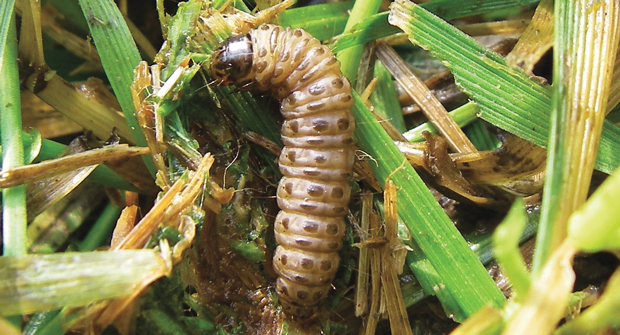The sod webworm, known for its insatiable appetite for grass, causes significant damage to different types of turf, adding to the list of pests that cause trouble in the spring and summer months.
There are more than twenty species of sod webworm, with all following a similar life cycle, according to Richard Fletcher, technical services manager with Nufarm.
Adult female sod webworm moths lay eggs while flying over turf, typically during the evening. The young larvae spend the winter in thatch or just beneath the soil before becoming active and starting to feed in the spring, eventually transforming into adult moths.
Fletcher notes sod webworms can undergo two or more generations annually, contingent upon location. Southern regions may witness three or more generations, while northern areas experience fewer occurrences.
Sod webworms attack both warm- and cool-season turfgrass, favoring warm-season bermudagrass and St. Augustine grass in the South. Notably, if sod webworms appeared in a lawn the previous year, recurrence in the following year remains highly probable.
“When suspecting sod webworm presence in a lawn, confirmation requires verifying worm presence and evaluating the population for potential control measures like insecticide application,” Fletcher says.
He emphasizes ensuring comprehensive coverage for ingestion of the insecticide when applying it.
Detection
Lawn care operators (LCOs) can mistake sod webworm damage for other issues like disease, drought effects or even dog urine burns. Accurate identification of sod webworm problems is crucial.
Jared Hoyle, Ph.D., market development specialist for Corteva Agriscience, says there are a few surefire ways to know you have a sod webworm problem. The easiest is observing sod webworm adults flying low over turf in the evening signals their presence, as this is when they lay their eggs. The larvae emerge from thatch or just beneath the soil surface at night to feed on turf.
However, targeting the adult moths is ineffective as they’re not the root cause of turf damage.
Treatment
According to Hoyle, sod webworm larvae reside in thatch or below the soil surface, appearing at night to feed on turf, leading to visible damage later. Detecting these pests during their feeding times is challenging for LCOs, requiring alternative detection methods.
Hoyle recommends that LCOs use a 1 percent pyrethrin solution mixed with household detergent in water to confirm the presence of sod webworms. Pouring two gallons of this solution over a square yard of infested turf can prompt larvae to surface. Depending on the number of larvae detected per area, insecticide treatment may be advisable.
“Management with insecticide might be necessary if five or more sod webworm larvae are present per square foot,” says Jesse Benelli, Ph.D., green solutions specialist for Envu.
Benelli stresses the importance of initiating sod webworm management through cultural practices for a healthy lawn foundation.
Practices like proper fertilizer application, adequate watering and mowing at optimal turf-specific heights aid in maintaining dense turf. When pesticide application becomes necessary, Benelli outlines two strategies for LCOs.
First, employing contact pesticides like bifenthrin, a pyrethroid insecticide, can control present sod webworms. He adds that multiple applications are essential for areas with multiple sod webworm generations annually.
Alternatively, using pesticides with residual activity, such as tetraniliprole, a diamide insecticide, offers six or more weeks of control. While these pesticides have limited contact impact, ingestion by sod webworms maximizes efficacy. Some LCOs combine bifenthrin with tetraniliprole for heightened control.
Benelli acknowledges potential pyrethroid insecticide resistance in sod webworms but recommends frequent mode-of-action rotations among insecticides to hinder resistance development.
Mastering sod webworm management requires a comprehensive approach encompassing cultural practices and strategic pesticide use. Understanding their life cycle and employing precise identification methods empower efficient control, ensuring turf health and vitality.


